Positive Health Online
Your Country

Sounding Bowls: Craftsmanship, Art and Spirituality
listed in sound and music, originally published in issue 155 - February 2009
Sounding Bowls are round wooden instruments with tuned strings across the inside. Identified as unique in musical history by EMI magazine in 1991. www.windworld.com/back_issues/bi5-6.htm Begun as musical works of art, they are now sought after as therapy and healing instruments in diverse applications, including self-healing. Here their maker Tobias Kaye contemplates what might have caused this shift from art to healing, and describes the making and using of a Sounding Bowl.
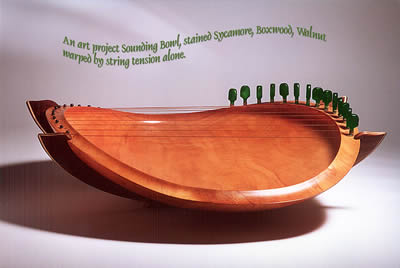
What is sound that it can break glass, infuse the heart with joy, carry meaning from mouth to ear or heal illness?
When the Bible declares: "In the beginning was the Word... all things were made by Him..." is this just poetry?
If sound does have such amazing qualities, could it really underlie the origins of all existence?
Modern science, as it is practised, has almost ceased to be real science and has fallen into mere technology, the discovery of how to do things rather than what things are really made of. Such advances, as noting that cells in the body communicate with pulses of light, were rubbished for many years before eventually becoming a (narrow) field of research. The problem seems to be that we are challenged in our very being, our sense of and security in who we are, by such questions. Our response normally is to bend the facts we know or discover to fit what we want to see. Before I move on allow me to give an example.
Trees grow not from the earth up into the air, but from the air down into the earth: More than half of the weight of a tree is water that rises and falls in cycles. Most of the rest is carbon united with small quantities of other minerals, forming wood. Our understanding through 20th century science is that through the miracle of photosynthesis, a leaf fixes carbon from air into solid matter (a process we do not understand or our energy problems would be over). Compounds created in the leaf feed down into the tree bonding into the small quantities of other minerals that rise from the ground to create wood. Thus, once the first leaves from the seed enter the air, a tree creates itself from the leaf downwards. Our insistence on looking on trees as though they grew from the earth up into the light blinds us to what we already know. Our insistence on looking on things as we are used to seeing them blinds us to what is really there.
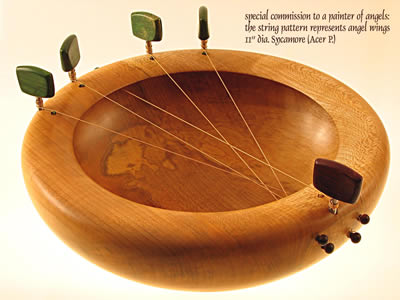
I believe that in our pursuit of ever finer particles of subatomic matter, we have already discovered things whose meaning we simply do not see. I know that a few leading thinkers have proposed that all matter is made of light, another upside down idea when most people believe today that light is made of matter. Researchers investigating the effects of sound have shown that fundamental changes in the patterns of matter can happen under the influence of sound. Fundamental changes can occur in the human body under the influence of our own thinking. All this adds up to concur with the ancient idea that the more you know the more you discover that you don't know.
Wonder – Key to Understanding
I want you to wonder. Wonder is the key to understanding. If we are sure of what we know we stop learning. By contrast, if we cultivate wonder the world opens up. The same section of the Bible goes on to declare that 'within the Word is Life and that Life is the light of Mankind.' Surely, if we cease to allow life into our thinking our growing ceases, and we begin the descent to a bitter old age.
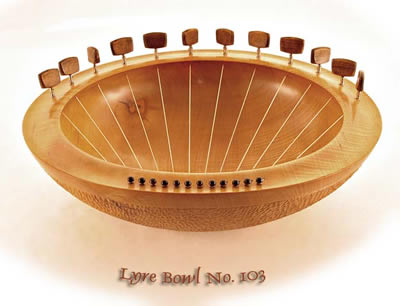
When St John says 'Word' does he really mean Sound as popular opinion seems to believe? For me there is another ingredient: intention. A spoken word is sound formed by intention. Intention lies behind all human action, all human creation. Perhaps St John's assertion is that some Intentional Creator lies behind/within all that exists, creating the world not in some far past but even as we look at it. If matter really were made up of light, formed into the elements by the deep underground sounds of the universe (the 'Music of the Spheres' of ancient Greece, Kalahari bushmen, etc.) then that sound, if formed by human intention and understanding, could change matter.
The key then becomes forming one's intention with sufficient understanding that one can tune in with the frequencies that create. You discover that this understanding is not new if you know certain ancient tales, such as the Irish legend Lusmore in which the hero's ability to sing the song of the faeries in an improved version heals his body www.sacred-texts.com/neu/celt/mcft/mcft14.htm
Sound Craftsmanship
All this may be interesting speculation, but as a craftsman, I deal with machines and lumps of wood on an everyday basis. My task is to cut the wood so that beautiful shapes result. I use very sharp, heavy steel tools for this while the wood is spinning on a lathe. www.tobias-kaye.co.uk/default.asp. I also teach others this craft. What I have found is that even in this machine-dominated environment it is possible to be sensitive to the structure of the wood. One can actually tune in to the frequencies of the cut, and adjust the ones working so that the wood does not break and spoil under the tool, but cuts cleanly and sweetly. This is simply called good craftsmanship; surprisingly few people practise this today, yet it remains a way of calling one's being into harmony with the world.
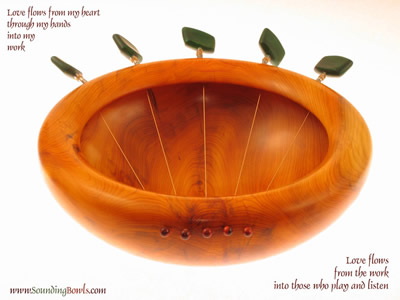
How one works is important, so also is what one makes. Here craftsmanship becomes art or design. Having been a keen amateur musician, my own designs, ten years before I dreamt of making an instrument, were already steeped in music. I saw the flow of melody in a line of curve and sought to make shapes that would express an 'innate harmony'.
During ten years of selling work in art galleries and craft markets I deepened my understanding of what you might call the 'voice of form', trying to express deep philosophies in the simple relationship of one part of a bowl-form to another, in the flow of curve and integrity of the whole. As I did so I slowly realized that more and more acoustic depth was appearing in the bowls. Held to the ear, a well-formed shape harmonized the environmental noise. Held in front of the mouth it made music of the voice. A potential was emerging with which I did not know what to do.
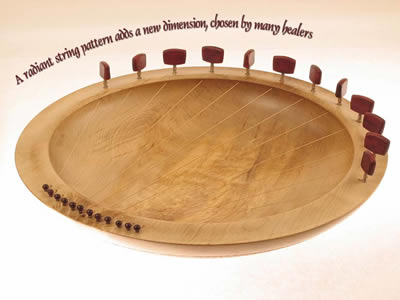
Truly, I would not have known where to go or what to do with this effect had not a composer friend told me straight that something needed to be done. Weeks of brainstorming produced no usable results. I had given up when one night as I was doing my meditation, into my vision came a wooden bowl with a string stretched across the inside.
The experience of stretching that string, of first hearing a note emerge from inside a bowl was powerful. For years, each time I tensed the first string and heard the inside shape of the wooden bowl speak felt like seeing a new life born. I realized that the musical imaginations of melody creating curve that had gone into so many shapes had emerged, again bearing audible beauty. Intentionality had formed the shape, the shape spoke its own 'in-tension' its own 'Life'.
Excitedly I researched shapes anew. Were there factors in shape that would guarantee a good sound, depth, size of opening, pattern or placement of strings? What would give the best sound? Eventually, I gave up seeking a formula, I got the best results by imagining the sound I wanted, hearing it with inner ear as I approached the wood, as I sculpted the shape, feeling it in my arms as I held the gouge and swung with the curve.
Most of the first 30 sold through art galleries, but during that time music therapists had discovered them and orders started coming through hospitals and clinics whose therapists had seen results elsewhere and wanted such an instrument for their own work.
Music of Therapists
Most music therapists in this country use the Nordoff-Robbins technique. www.nordoff-robbins.org.uk/ A client can make sound or music with any of a range of very simple instruments, maybe just a shaker or gong, and the therapist applies years of musical and therapeutic skill to improvise on a piano, guitar or such to make the client's sound feel part of something larger and more richly expressive. Much like a talk therapist will help a client to understand how their problems are part of the wider picture of being human, so a music therapist helps the client to feel that the emotions present in their music are part of something meaningful and potentially beautiful. A music therapist working like this can, over a number of sessions, help the client to achieve remarkable results, possibly going deeper than talk could ever go; this form of therapy is practised in many hospices and hospitals, psychiatric and otherwise.
From the very first time a Sounding Bowl went into an institution, results were remarkable. Using a very small one supplied to him in an Oxford hospice, Dr Colin Lee was deeply impressed. He assisted in organizing a mini conference of colleagues in London, specifically to tell people about the breakthroughs he had made with this new instrument. Today, institutes all over the world are using Sounding Bowls.
Some of England's best known psychiatric 'prisons' have commented that getting a Sounding Bowl took their music therapy work 'onto a whole new level', and assisted patients there who had reached maintenance level in therapy years before to start making progress again. Many of them will cuddle the Sounding Bowl as though it were a child, rather than holding it like another instrument. One man who had not shown any emotion in 16 years, was able to break down in tears while holding and playing it.
Working with Autistic children presents any therapist with a difficulty. A therapeutic relationship is barely possible with someone who shuts out all relationship. Getting the child's interest is a daily task. Finding something in which an autistic child will take a spontaneous interest is a huge benefit. Many music therapists have told me with delight that once they had a Sounding Bowl their work became hugely easier; children who had spent many sessions avoiding relationship with anything, took a lively interest in a Sounding Bowl, and from there would allow a relationship with the therapist to grow.
There are many touching stories from many different applications: Of healers finding white light pouring out of their sounding bowls into their clients, of hospice patients emerging from weeks of deep depression, of behaviourally disturbed youths finding something they could treat with respect and gentleness. A few samples have been gathered on the Sounding Bowls website: www.SoundingBowls.com . Somehow, something happens around Sounding Bowls that softens situations, opens hearts, and brings hope.
As a maker it constantly amazes me. A client comes in, sees a Sounding Bowl, takes it up, admires it, then on making a sound they change, their eyes soften or open wider, tears may form or an exclamation of delight or amazement may escape them. Healers may then tell me of how it opens their chakras, streaming down through one after another, leaving them vibrant. Others may simply say that this is what they need in their lives.
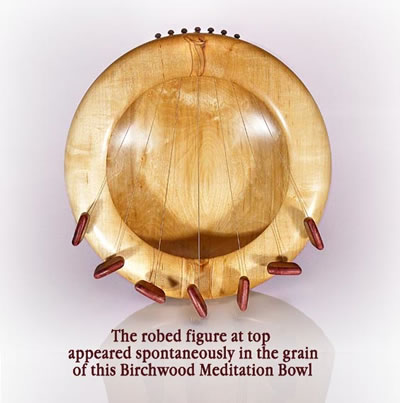
It is not therapists alone who use Sounding Bowls, who say they can no longer imagine working without one; there are many private users who have found valuable effects in their lives from playing one, whether that be simply to bring music into their lives where a piano or guitar has failed to inspire, or whether it be as a tool of meditation or self-healing. Handmade wooden instruments are never cheap, but special results rarely are, in any field of human endeavour.
How this all works I don't know. I do not see white light myself, nor am I a trained therapist, but I do feel as though there is a hard-to-define link between my own intentionality and a higher intention. I do feel there is a link between the visible beauty of the instrument and its beautiful sound; I also feel that there is some sort of a link between the intention to seek innate harmony and the eventual emergence of a sound with healing effects.
Consciously I can take a lump of suitable wood and change it from being a bit of tree into a resonating instrument. Consciously I am not sure that I can give it any of these remarkable healing abilities. It is such things that are a mystery to me, yet weekly I see and hear more results from these remarkable instruments that I am truly graced to be able to make. Sound formed by intention, wood formed by hand, sound moving in, sound emerging, intention from beyond.
Comments:
-
No Article Comments available